VxRail Hyper Converged Devices
According to the ESG study, 70% of companies from the IT segment in the next couple of years plan to allocate funds for hyperconvergent systems. And this is not by chance. Flexible and scalable hyperconvergent infrastructures enable you to deploy a private cloud and take advantage of cloud services.

In February 2016, the VxRail system appeared - an infrastructure solution for VMware environments, which combines virtualization, computing resources, storage and data protection system. The 2x-high compact VxRail chassis contains four servers (i.e., four nodes) and 24 HDD or SSD drives. It also includes the Virtual SAN software-defined data storage.
The system can be scaled from 3 to 64 nodes, and the characteristics will grow almost linearly. 64 nodes in 16 blocks capable of supporting 3200 virtual machines. No external arrays and storage networks are required.
High-performance versions for support of intensive loading are completed with flash memory of more than 76 TB, DRAM memory of 2 TB and 112 computational cores.
')
In October 2016, Dell EMC updated this lineup with the release of the VxRail Appliance hyper-convergent devices with integrated PowerEdge servers. New products offer more flexibility in hardware configurations and a smaller scaling step. In total, more than 250 different configurations are supported, for the same price, customers receive 40% more computing power, and the initial price is reduced by 25% and is less than 45 thousand dollars. At the same time, nodes based on flash drives have five times more capacity.
Dell EMC currently offers several hyperconvergent models: stand-alone VxRail devices for VMware environments and XC series devices for other virtualization environments, rack-mount VxRack 1000 systems with SDDC nodes and VMware environments, and VxRack 1000 environments with Flex nodes for scalable enterprise environments.
VxRail is a compact integrated device (appliance) with a height of 2U with four server nodes. Its qualities are ease of use, economy, minimal initial configuration with the possibility of expansion. Depending on the model, it may have a hybrid storage or contain only flash drives. One device can support up to 200 virtual machines. If further scaling is needed, up to 16 VxRail devices can be combined into a cluster, designed to support up to 3000 VMs. Target clients are medium business and regional offices of large enterprises.
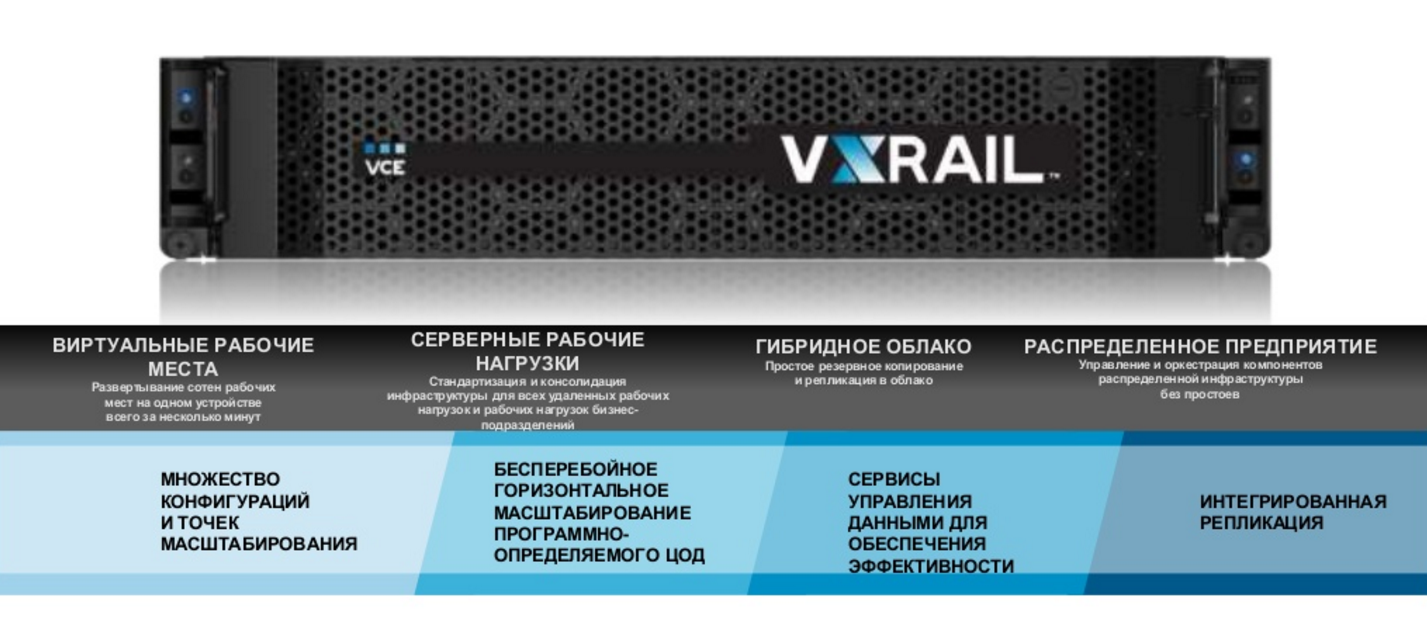
The VxRail Hyper-Converged Device is the result of a partnership between Dell EMC and VMware.
The scope of this solution:
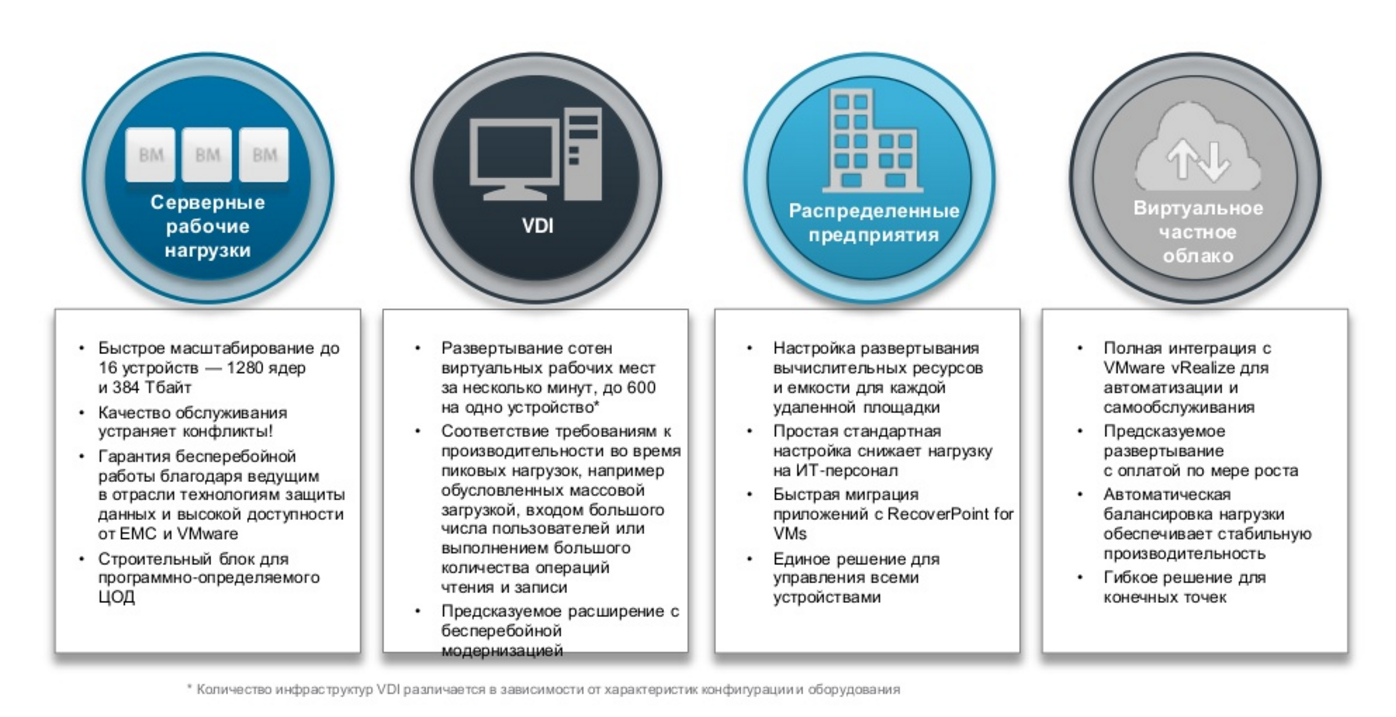
VxRail usage scenarios.
Such a system can have many configurations and scaling points, provides horizontal scaling of the software-defined data center without interrupting work. It also provides integrated data management and replication services.

One VxRail system consists of four nodes. Each node includes a processor, RAM, power and cooling subsystems, 1 or 10 Gb / s network interfaces, graphics processors, and hybrid or flash drives.
VMware Virtual SAN software provides convenient storage resource management and fault tolerance through software-defined policies, increases the efficiency of their use, balances storage resources according to VM service policies. This is the best SDS technology for VMware environments.
Compared with the implementation of SDS based on special VMs (Virtual Storage Appliance - VSA), vSAN increases the efficiency of CPU utilization by two and memory three times, allows you to use the built-in vMotion and DRS functions, and apply control and policy to each VM. VxRail also includes data services - deduplication, SLA for each client, data protection services, cloud storage, data compression, etc., and, of course, management services.
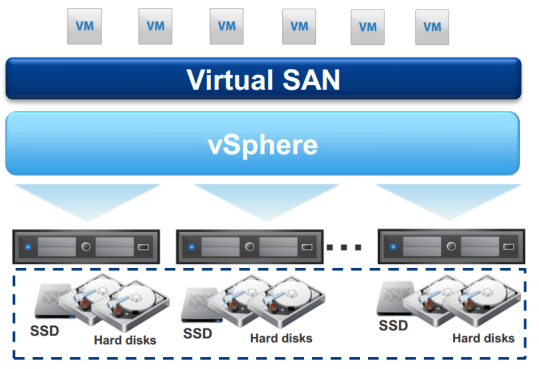
At the heart of VxRail - vSAN.
VxRail is bundled with Virtual SAN Enterprise, vCenter Server, vRealize Log insight with VxRail Manager deployment and support tools and Secure Remote Support. And built-in data protection includes RecoverPoint for VMs, Cloudarray, vSphere Replication, vSphare Data Protection.
For optimal performance of VxRail, a vSphere Enterprise Plus license is recommended, increasing the efficiency of administrators through automated workload balancing, simplified disk replacement, and simple software updates.
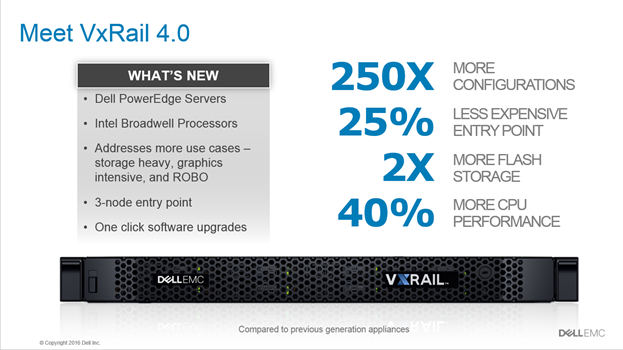
VxRail 4.0 supports more usage scenarios (250 times more configurations), can be used for active processing of graphic data, used in remote offices and branches.
The VxRail 4.0 system on Dell PowerEdge servers with Intel Broadwell processors - the 5th generation Xeon (1.7-3.5 GHz, 8-44 cores), which are 40% more productive than previous generation processors, became a novelty of the forum. The flash memory capacity is doubled - up to 48 TB per node.
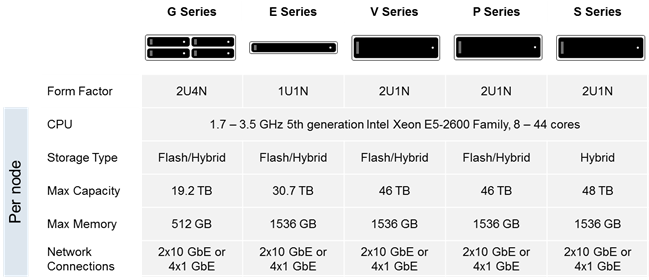
Customers can choose for their tasks from a larger number of processors, memory tanks, etc. You can use 1U or 2U nodes of five different series. The P c GPU series is designed specifically for VDI.
As an entry-level solution, a system of three, rather than four nodes is now proposed. The node has a RAM capacity of 512 or 1536 GB. 24 DIMM slots support 16/32 GB LDIMMs or 64 GB LRDIMM modules. NVIDIA and AMD GPUs are used as GPUs, but software and drivers for them are sold separately.
Network interfaces are two 10GbE ports or four GbE (SFP + or RG45). In a VxRail cluster, you cannot combine nodes with different network interfaces and different storage subsystems (in flash memory and hybrid storages) due to different performance.
VxRail has a low cost per gigabyte of stored data and a low total cost of ownership. In the 6U rack space, 132 computing nodes, 138 TB of flash memory are located. Nodes on flash drives are actually offered at the price of hybrid solutions. Plus, data management services, deduplication, compression, predictable performance of flash systems.

VxRail: all inclusive.
Opportunities for scaling and upgrading nodes minimize risks and gradually acquire resources, increasing the system from 3 to 64 nodes to increase its capacity and performance. In addition to horizontal scaling such a system can be easily upgraded. For this, it is enough to add a new device to the cluster, transfer the workload to it using vMotion and delete the old node without interrupting the work.
What are the suggested controls and orchestrations? To work with virtual machines there is a vCenter Server - a single control panel for one or several clusters. For installation and upgrading, you can use VxRail Manager with the app store. vRealize Automation solves automation problems. This software provides strategic management and control, uses automation templates and offers a self-service catalog. For IT operations, you can use vRealize Operations with integrated analysis, capacity management and proactive alerts.
VxRail also offers built-in and advanced data protection. embedded are distributed clusters that operate in active-active mode and provide continuous availability for disaster recovery. There are RecoverPoint for VM with the ability to restore the state at any time (five licenses per node are included), vSphere Replication with point-in-time recovery, and vSphere Data Protection with 8 TB of capacity for backup and recovery (with deduplication).
Advanced data protection includes Data Protection Suite for VMware with detailed backup and recovery and Data Domail Virtual Edition, a simple software-defined platform with up to 96 TB capacity scaling. It includes DD Boost, DD Replicator, and DD Encryption.
What is VxRail used for? Typical tasks are virtual environments, business applications, remote offices, virtual desktops, testing and development. In general, this solution simplifies the deployment and operation of VMware environments and reduces capital and operational costs.
VxRail is suitable for traditional server workloads, deployment of virtual desktops (VDI), it is convenient to use in branches of distributed companies and to build clouds, including hybrid environments. Such hyperconvergent solutions are suitable for any virtualized applications. It is not by chance that, according to Gartner, they represent today the fastest growing trend in the IT infrastructure.
Dell EMC offers the most comprehensive portfolio of converged and hyperconvergent solutions, covering different levels: devices, racks and blocks. The choice of solutions depends on the use case.
The convergent platform VxRail, in combination with its senior counterparts from VCE, can be an attractive solution for retailers, the banking sector and a number of other organizations of different profiles, companies with a geographically distributed structure. By keeping investments in the existing VMware environment, they can reduce complexity and reduce costs. Dell EMC offers customization and application migration services to the new platform.

In February 2016, the VxRail system appeared - an infrastructure solution for VMware environments, which combines virtualization, computing resources, storage and data protection system. The 2x-high compact VxRail chassis contains four servers (i.e., four nodes) and 24 HDD or SSD drives. It also includes the Virtual SAN software-defined data storage.
The system can be scaled from 3 to 64 nodes, and the characteristics will grow almost linearly. 64 nodes in 16 blocks capable of supporting 3200 virtual machines. No external arrays and storage networks are required.
High-performance versions for support of intensive loading are completed with flash memory of more than 76 TB, DRAM memory of 2 TB and 112 computational cores.
')
In October 2016, Dell EMC updated this lineup with the release of the VxRail Appliance hyper-convergent devices with integrated PowerEdge servers. New products offer more flexibility in hardware configurations and a smaller scaling step. In total, more than 250 different configurations are supported, for the same price, customers receive 40% more computing power, and the initial price is reduced by 25% and is less than 45 thousand dollars. At the same time, nodes based on flash drives have five times more capacity.
Dell EMC currently offers several hyperconvergent models: stand-alone VxRail devices for VMware environments and XC series devices for other virtualization environments, rack-mount VxRack 1000 systems with SDDC nodes and VMware environments, and VxRack 1000 environments with Flex nodes for scalable enterprise environments.
VxRail is a compact integrated device (appliance) with a height of 2U with four server nodes. Its qualities are ease of use, economy, minimal initial configuration with the possibility of expansion. Depending on the model, it may have a hybrid storage or contain only flash drives. One device can support up to 200 virtual machines. If further scaling is needed, up to 16 VxRail devices can be combined into a cluster, designed to support up to 3000 VMs. Target clients are medium business and regional offices of large enterprises.

The VxRail Hyper-Converged Device is the result of a partnership between Dell EMC and VMware.
The scope of this solution:
| Using | What does it give |
| Virtual Jobs | Deploying hundreds of jobs in minutes on one device |
| Standard Workloads | Standardization and consolidation of infrastructure for all workloads of remote sites and divisions |
| Hybrid cloud | Uninterrupted backup and replication to the cloud |
| Distributed enterprise | Fast deployment of hundreds of remote sites with minimal cost |

VxRail usage scenarios.
Such a system can have many configurations and scaling points, provides horizontal scaling of the software-defined data center without interrupting work. It also provides integrated data management and replication services.

One VxRail system consists of four nodes. Each node includes a processor, RAM, power and cooling subsystems, 1 or 10 Gb / s network interfaces, graphics processors, and hybrid or flash drives.
VMware Virtual SAN software provides convenient storage resource management and fault tolerance through software-defined policies, increases the efficiency of their use, balances storage resources according to VM service policies. This is the best SDS technology for VMware environments.
Compared with the implementation of SDS based on special VMs (Virtual Storage Appliance - VSA), vSAN increases the efficiency of CPU utilization by two and memory three times, allows you to use the built-in vMotion and DRS functions, and apply control and policy to each VM. VxRail also includes data services - deduplication, SLA for each client, data protection services, cloud storage, data compression, etc., and, of course, management services.

At the heart of VxRail - vSAN.
VxRail is bundled with Virtual SAN Enterprise, vCenter Server, vRealize Log insight with VxRail Manager deployment and support tools and Secure Remote Support. And built-in data protection includes RecoverPoint for VMs, Cloudarray, vSphere Replication, vSphare Data Protection.
For optimal performance of VxRail, a vSphere Enterprise Plus license is recommended, increasing the efficiency of administrators through automated workload balancing, simplified disk replacement, and simple software updates.

VxRail 4.0 supports more usage scenarios (250 times more configurations), can be used for active processing of graphic data, used in remote offices and branches.
The VxRail 4.0 system on Dell PowerEdge servers with Intel Broadwell processors - the 5th generation Xeon (1.7-3.5 GHz, 8-44 cores), which are 40% more productive than previous generation processors, became a novelty of the forum. The flash memory capacity is doubled - up to 48 TB per node.

Customers can choose for their tasks from a larger number of processors, memory tanks, etc. You can use 1U or 2U nodes of five different series. The P c GPU series is designed specifically for VDI.
As an entry-level solution, a system of three, rather than four nodes is now proposed. The node has a RAM capacity of 512 or 1536 GB. 24 DIMM slots support 16/32 GB LDIMMs or 64 GB LRDIMM modules. NVIDIA and AMD GPUs are used as GPUs, but software and drivers for them are sold separately.
Network interfaces are two 10GbE ports or four GbE (SFP + or RG45). In a VxRail cluster, you cannot combine nodes with different network interfaces and different storage subsystems (in flash memory and hybrid storages) due to different performance.
VxRail has a low cost per gigabyte of stored data and a low total cost of ownership. In the 6U rack space, 132 computing nodes, 138 TB of flash memory are located. Nodes on flash drives are actually offered at the price of hybrid solutions. Plus, data management services, deduplication, compression, predictable performance of flash systems.

VxRail: all inclusive.
Opportunities for scaling and upgrading nodes minimize risks and gradually acquire resources, increasing the system from 3 to 64 nodes to increase its capacity and performance. In addition to horizontal scaling such a system can be easily upgraded. For this, it is enough to add a new device to the cluster, transfer the workload to it using vMotion and delete the old node without interrupting the work.
What are the suggested controls and orchestrations? To work with virtual machines there is a vCenter Server - a single control panel for one or several clusters. For installation and upgrading, you can use VxRail Manager with the app store. vRealize Automation solves automation problems. This software provides strategic management and control, uses automation templates and offers a self-service catalog. For IT operations, you can use vRealize Operations with integrated analysis, capacity management and proactive alerts.
VxRail also offers built-in and advanced data protection. embedded are distributed clusters that operate in active-active mode and provide continuous availability for disaster recovery. There are RecoverPoint for VM with the ability to restore the state at any time (five licenses per node are included), vSphere Replication with point-in-time recovery, and vSphere Data Protection with 8 TB of capacity for backup and recovery (with deduplication).
Advanced data protection includes Data Protection Suite for VMware with detailed backup and recovery and Data Domail Virtual Edition, a simple software-defined platform with up to 96 TB capacity scaling. It includes DD Boost, DD Replicator, and DD Encryption.
What is VxRail used for? Typical tasks are virtual environments, business applications, remote offices, virtual desktops, testing and development. In general, this solution simplifies the deployment and operation of VMware environments and reduces capital and operational costs.
VxRail is suitable for traditional server workloads, deployment of virtual desktops (VDI), it is convenient to use in branches of distributed companies and to build clouds, including hybrid environments. Such hyperconvergent solutions are suitable for any virtualized applications. It is not by chance that, according to Gartner, they represent today the fastest growing trend in the IT infrastructure.
Dell EMC offers the most comprehensive portfolio of converged and hyperconvergent solutions, covering different levels: devices, racks and blocks. The choice of solutions depends on the use case.
The convergent platform VxRail, in combination with its senior counterparts from VCE, can be an attractive solution for retailers, the banking sector and a number of other organizations of different profiles, companies with a geographically distributed structure. By keeping investments in the existing VMware environment, they can reduce complexity and reduce costs. Dell EMC offers customization and application migration services to the new platform.
Source: https://habr.com/ru/post/321538/
All Articles